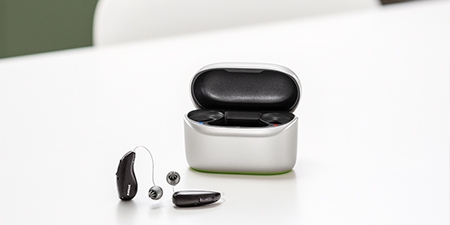What is Mixed Hearing Loss? Causes, Symptoms, Treatments and the Spectrum of Hearing Impairment

What is Mixed Hearing Loss? Causes, Symptoms, Treatments and the Spectrum of Hearing Impairment
15 min
Published November 4, 2025
By understanding each type of hearing loss we are better able to find the right solutions that put us back on the path to better hearing
Mixed hearing loss is a complex condition that can be divided into two main categories of hearing loss: Conductive Hearing Loss (CHL) and Sensorineural Hearing Loss (SNHL). Understanding mixed hearing loss is important because it involves various causes, signs, symptoms and treatment options that can affect the way a person hears and listens.
What Are the Four Types of Hearing Loss?
Causes of Mixed Hearing Loss
The causes of mixed hearing loss may vary, and it arises from a combination of conductive and sensorineural factors. Conductive causes may include ear infections, fluid in the middle ear, perforated eardrums, or abnormalities in the ear canal or ossicles (the tiny bones in the middle ear). Sensorineural components often result from aging, noise exposure, head trauma, or conditions affecting the inner ear or auditory nerve. This dual nature means that both the transmission of sound through the outer or middle ear and the processing of sound in the inner ear or brain are impaired.
This may occur as a result of:
- Congenital Factors: Some people may be born with conditions that affect their hearing, known as congenital factors.
- Viral Infections: Research has shown that certain viruses can seriously harm hearing skills. For example, a study by Cohen et al. In 2014 highlighted that viral infections can play a major role in causing mixed hearing loss¹.
Signs of Mixed Hearing Loss
Signs of mixed hearing loss may differ from person to person. However, some common signs include difficulty hearing soft sounds and having trouble understanding speech, especially in noisy environments. According to Michels, Duffy and Rogers in 2019, people with mixed hearing loss often find it difficult to follow conversations when there is background noise, which can be frustrating in social situations².
Individuals may also notice that sounds seem damped or unclear. Since the loss of mixed hearing combines different problems, careful evaluation is required to identify specific causes and customize the right treatment plan.
Treatment Options for CHL vs SNHL
The distinction between conductive and sensorineural hearing loss is essential because treatment approaches vary widely for each type.
- For Conductive Hearing Loss, treatments may include medical or surgical interventions such as removing blockages or repairing damaged parts of the outer or middle ear. In some cases, hearing aids may be recommended to help amplify sounds.
- For Sensorineural Hearing Loss, however, options may be limited as it usually requires long-term solutions. Hearing aids are commonly used to amplify sound; In some cases, cochlear implants may be recommended for individuals with severe or profound hearing loss.
Treatment for Mixed Hearing Loss
Overall, mixed hearing loss is multifaceted, involving different contributing factors that affect how well an individual can hear. Understanding the differences between conductive and sensorineural hearing loss helps to provide appropriate treatments that can better serve those affected. The combination of signs, symptoms and treatment options makes a mixed hearing loss a significant concern that requires careful management and attention.

Different treatments can work better for different patients, depending on their exclusive needs and the causes of their hearing loss.
Hearing Aids & Assistive Listening Devices
In addition to surgery, many patients can benefit from non-invasive treatments, making hearing aids and assistive listening devices popular choices. Hearing aids amplify sounds, facilitating people with hearing loss to hear conversations and sounds around them. These devices can be customized to adapt to the specific type and severity of the hearing loss that a person has⁴. Assistive listening devices such as FM or Loop systems can be used in various settings, including classrooms or theaters. These devices are designed to help people hear better in noisy environments.
Opportunity intervention is critical in addressing mixed hearing loss. Current clinical guidelines emphasize that if you suddenly notice a hearing loss you should seek medical help immediately. Delays in treatment may worsen the condition and impair recovery⁵. Sometimes fast action can lead to better results and can avoid further damage to the ears.
Health professionals play a key role in treating mixed hearing loss. They need to remain up to date on the latest treatment methods and recommended practices. This includes being aware of congenital factors - those present at birth - which can contribute to mixed hearing loss. For example, some children may be born with conditions that affect the middle and inner ear⁶. Understanding these factors is critical to creating effective treatment plans.
Overall, treatment of mixed hearing loss involves a careful assessment of each patient's needs, the causes of their hearing loss and the best methods available to manage it. By employing a combination of surgical options using hearing aids and promoting early intervention, healthcare providers can work to improve hearing skills and the quality of life of individuals suffering from mixed hearing loss.
Developments in Diagnosing & Treating Mixed Hearing Loss
The current research continues to explore new horizons in the field of Audiology, focusing on innovative therapies and improving the care of patients through practices based on evidence⁷. While scientists learn more about hearing loss, they also discover new ways to diagnose and treat problems such as mixed hearing loss.
In the field of Audiology, researchers are focusing on best diagnostic tools to distinguish between the various types of hearing loss.
Understanding the distinctions between conductive hearing loss and sensory-neural hearing loss is crucial for healthcare professionals. The loss of conductive hearing often benefits from medical or surgical treatments aimed at improving the transmission of sound. On the contrary, the loss of sensory hearing usually requires more permanent solutions such as hearing aids or cochlear implant systems as it involves damage to the internal mechanisms of the ear or nerve paths. This complexity highlights why the personalization of care strategies for people with mixed hearing loss is so important. Each patient has unique needs and challenges and research in progress aims to improve the quality of the care they receive through evidence-based approaches⁸.
References
¹ Cohen, B. E., Durstenfeld, A., & Roehm, P. C. (2014). Viral causes of hearing loss: a review for hearing health professionals. Trends in hearing, 18, 2331216514541361. https://journals.sagepub.com/doi/abs/10.1177/2331216514541361
² Michels, T. C., Duffy, M. T., & Rogers, D. J. (2019). Hearing loss in adults: differential diagnosis and treatment. American family physician, 100(2), 98-108. https://www.aafp.org/pubs/afp/issues/2019/0715/p98.html
³ Ernst, A., Todt, I., & Wagner, J. (2016). Safety and effectiveness of the Vibrant Soundbridge in treating conductive and mixed hearing loss: A systematic review. The Laryngoscope, 126(6), 1451-1457. https://onlinelibrary.wiley.com/doi/abs/10.1002/lary.25670
⁴ Müller, U., & Barr-Gillespie, P. G. (2015). New treatment options for hearing loss. Nature reviews Drug discovery, 14(5), 346-365. https://www.nature.com/articles/nrd4533
⁵ Chandrasekhar, S. S., Tsai Do, B. S., Schwartz, S. R., Bontempo, L. J., Faucett, E. A., Finestone, S. A., ... & Satterfield, L. (2019). Clinical practice guideline: sudden hearing loss (update). Otolaryngology–Head and Neck Surgery, 161(1_suppl), S1-S45. https://journals.sagepub.com/doi/abs/10.1177/0194599819859885
⁶ Korver, A. M., Smith, R. J., Van Camp, G., Schleiss, M. R., Bitner-Glindzicz, M. A., Lustig, L. R., ... & Boudewyns, A. N. (2017). Congenital hearing loss. Nature reviews Disease primers, 3(1), 1-17. https://www.nature.com/articles/nrdp201694
⁷ Sataloff, R. T., & Roehm, P. C. (Eds.). (2024). Hearing loss. CRC Press. https://books.google.com/books?hl=en&lr=&id=lG0iEQAAQBAJ&oi=fnd&pg=PP1&dq=Mixed+hearing+loss+causes,+symptoms,+treatment%3B+types+of+hearing+loss,+conductive+vs+sensorineural.&ots=Y1HmwwPDEB&sig=gF2Dh6CnGbg6w3_gSZNRWseythM
⁸ Lasak, J. M., Allen, P., McVay, T., & Lewis, D. (2014). Hearing loss: diagnosis and management. Primary Care: Clinics in Office Practice, 41(1), 19-31. https://www.primarycare.theclinics.com/article/S0095-4543(13)00099-7/abstract




